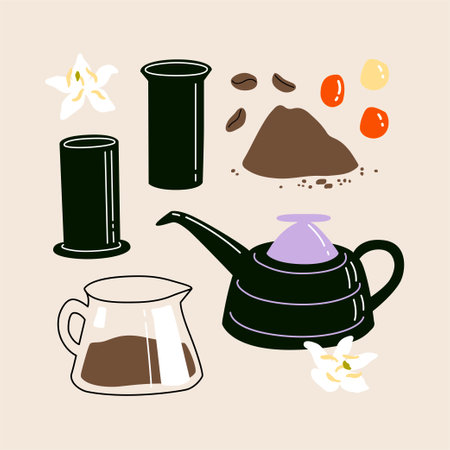1. What Is a Moka Pot?
The Moka pot is a classic stovetop coffee maker that has stood the test of time, earning a spot in kitchens around the world—especially in the United States. Originally invented in Italy in 1933 by Alfonso Bialetti, this iconic brewer was designed to make strong, rich coffee at home without the need for expensive espresso machines.
Shaped like a small hourglass and typically made from aluminum or stainless steel, the Moka pot consists of three main parts: a bottom chamber for water, a metal filter basket for ground coffee, and an upper chamber where the brewed coffee collects. As the water heats up on the stove, pressure pushes it through the coffee grounds and into the top section, creating a bold, concentrated brew thats similar to espresso.
Why Its Loved in American Homes
Over the years, the Moka pot has gained popularity across America for its simplicity and ability to make café-quality coffee right on the stovetop. It’s especially favored by those who enjoy stronger coffee without investing in high-end espresso machines. Many people appreciate its compact size, affordability, and timeless design—which often adds a touch of European charm to their kitchen counters.
Key Features of a Moka Pot
| Feature | Description |
|---|---|
| Origin | Invented in Italy in 1933 by Alfonso Bialetti |
| Material | Usually aluminum or stainless steel |
| Coffee Style | Strong and rich, similar to espresso |
| Brew Method | Stovetop pressure-based extraction |
| Popularity in U.S. | Loved for its simplicity, affordability, and flavor quality |
A Timeless Brewing Tool
The Moka pot continues to be a go-to choice for many American coffee lovers who want full-bodied flavor without fancy equipment. Whether you’re new to home brewing or looking to upgrade your morning routine, understanding what a Moka pot is—and why it’s so popular—is the perfect place to start your journey toward making incredible coffee at home.
2. Choosing the Right Moka Pot
Picking the right Moka pot is a big part of brewing great coffee at home. With so many options out there, it can feel overwhelming at first—but don’t worry. We’ll break it down into easy steps to help you choose the perfect one for your needs.
Size Matters: How Many Cups?
Moka pots come in different sizes, usually measured in “cups.” But keep in mind—a Moka pot “cup” is not your standard 8-ounce mug. It’s closer to 1.5 ounces of espresso-like coffee. So if youre brewing for more than one person or like a larger cup, consider a bigger size.
| Moka Pot Size | Approximate Yield | Best For |
|---|---|---|
| 1-cup | 1.5 oz | Solo drinkers or espresso lovers |
| 3-cup | 4.5 oz | One strong cup or two small servings |
| 6-cup | 9 oz | Couples or small households |
| 9-cup and above | 13.5+ oz | Larger families or gatherings |
Material: Aluminum vs. Stainless Steel
The most common materials for Moka pots are aluminum and stainless steel, each with their own pros and cons.
| Material | Pros | Cons |
|---|---|---|
| Aluminum | Lightweight, affordable, classic Italian design (like the original Bialetti) | Not dishwasher safe, prone to corrosion over time if not dried properly, not ideal for induction stovetops |
| Stainless Steel | Durable, dishwasher safe, works on all stovetops including induction | Tends to be pricier and heavier than aluminum models |
Popular Brands Available in the U.S.
If youre shopping in the United States, here are some trusted brands you’ll likely find online or in stores like Target, Walmart, or on Amazon:
- Bialetti: The OG of Moka pots—iconic design and solid performance. Known for their classic aluminum models like the Moka Express.
- Cuisinox: High-quality stainless steel options that are built to last and great for modern kitchens.
- Tops: American-made stainless steel Moka pots with a simple design and reliable performance.
- Zulay Kitchen: A budget-friendly option with decent quality; good for beginners trying out Moka brewing for the first time.
- Bellemain: Another affordable choice often found online; offers both aluminum and stainless steel models.
Quick Tips When Choosing:
- If you have an induction stove, go with stainless steel unless you have an adapter plate.
- If youre new to Moka pots, starting with a 3-cup size is often a safe bet—it’s versatile without being too much or too little.
- If style matters to you (and hey, why not?), look for color options or modern designs—some brands offer sleek matte black or pastel finishes.
The right Moka pot makes all the difference in your home brewing experience. Whether youre looking for a daily ritual or something special on weekends, choosing the right size and material sets you up for success.

3. Coffee Beans and Grind Size
When it comes to brewing with a Moka pot, the type of coffee beans you choose and how finely you grind them can make or break your brew. Since American coffee preferences tend to lean toward bold flavors with a smooth finish, youll want to pick beans and grind settings that bring out the best in your Moka pot.
Choosing the Right Coffee Beans
The Moka pot brews strong, espresso-like coffee, so its best to go with beans that can handle high pressure and heat without tasting burnt or overly bitter. Here are some tips for picking the right beans:
Bean Roast Level
| Roast Level | Flavor Profile | Best For Moka Pot? |
|---|---|---|
| Light Roast | Bright, acidic, floral notes | No – tends to taste sour or sharp under high pressure |
| Medium Roast | Balanced, slightly sweet, nutty | Yes – great balance of flavor and body |
| Dark Roast | Bold, smoky, chocolatey notes | Yes – preferred by many for its strong flavor |
Coffee Origin Tips
If youre into more complex flavors, try single-origin beans from Latin America for nutty and chocolatey notes—favorites among U.S. coffee drinkers. Blends are also a solid choice if you like a well-rounded cup.
The Ideal Grind Size for Moka Pot Brewing
This part is crucial. The grind size affects how fast water passes through the grounds, which impacts both flavor and pressure. For Moka pots, you need something between an espresso and drip coffee grind.
Grind Size Comparison Table
| Brew Method | Grind Size | Description |
|---|---|---|
| Espresso Machine | Fine | Feels like powdered sugar; too fine for Moka pot |
| Moka Pot (Recommended) | Medium-Fine | Slightly coarser than espresso; feels like table salt |
| Drip Coffee Maker | Medium | Feels like sand; too coarse for proper extraction in Moka pot |
Pro Tip:
If your coffee tastes bitter or harsh, your grind may be too fine. If it tastes weak or sour, it might be too coarse. Adjust until you hit that sweet spot!
Pre-Ground vs Whole Bean: Whats Better?
If possible, always go for whole bean coffee and grind just before brewing. This keeps the flavors fresh and allows you to dial in the perfect grind size for your Moka pot. But if convenience is key, look for pre-ground coffee labeled “Moka” or “stovetop espresso.” Just double-check the grind—it should feel like fine sand.
The right beans and grind size are essential to get that rich, full-bodied cup that American coffee lovers enjoy from their Moka pots.
4. Step-by-Step Brewing Instructions
Brewing coffee with a Moka pot might seem intimidating at first, but once you get the hang of it, it becomes second nature. Follow these simple steps to make rich and flavorful Moka pot coffee right in your kitchen. We’ll also highlight common mistakes and give you tips to avoid bitterness.
What You’ll Need:
- Moka pot (also known as a stovetop espresso maker)
- Freshly ground coffee (medium-fine grind)
- Filtered water
- A heat source (stove or portable burner)
- Towel or oven mitt (for safety)
Step-by-Step Instructions:
- Fill the bottom chamber with hot water: Use filtered water heated to just below boiling. Fill up to the safety valve—don’t cover it.
- Add ground coffee to the filter basket: Fill the basket with medium-fine ground coffee, leveling it off without tamping. Tamping can cause over-extraction and bitter flavors.
- Assemble the Moka pot: Carefully screw on the top chamber. Use a towel or mitt if the bottom is hot. Make sure its sealed tight but don’t overtighten.
- Place on the stove over medium heat: Keep the lid open so you can see when coffee starts to flow. Avoid high heat—it can burn the coffee and damage your pot.
- Watch for brewing: Coffee will start bubbling into the upper chamber. Once you hear a gurgling sound, most of the water has been pushed through.
- Remove from heat immediately: Take it off the stove as soon as you hear gurgling to prevent burnt flavors.
- Cool the base quickly (optional but recommended): Run cold water over the bottom chamber or wrap it in a cold towel. This stops extraction and helps avoid bitterness.
- Stir and serve: Before pouring, stir the coffee in the top chamber with a spoon to mix layers evenly for consistent flavor.
Tips to Avoid Bitterness
| Mistake | How to Fix It |
|---|---|
| Using cold water | Start with hot water to reduce time on heat and prevent metallic taste |
| Tamping coffee grounds | Just level off grounds; don’t compress them |
| Using too much heat | Brew over medium heat for better control and flavor |
| Leaving on heat too long | Remove from stove when you hear gurgling to avoid over-extraction |
| Not cleaning your Moka pot regularly | Rinse thoroughly after each use to prevent buildup that affects taste |
Common Mistakes to Watch Out For
- Poor grind size: Too fine can clog, too coarse makes weak coffee. Aim for a texture like table salt.
- Poor seal between chambers: Always check rubber gasket and threads before brewing.
- Poor quality beans: Fresh, high-quality beans make all the difference. Look for roast dates and store them properly.
If you follow these steps, you’ll get smooth, strong, and satisfying Moka pot coffee every time—without bitterness or hassle!
5. Cleaning and Maintenance Tips
Keeping your Moka pot clean isn’t just about looks—it’s key to making sure every cup of coffee tastes fresh and delicious. A well-maintained Moka pot can last for years, and taking care of it properly ensures you won’t get any funky flavors in your brew. Here’s how to keep your stovetop espresso maker in top shape with some easy cleaning and maintenance tips.
Daily Cleaning After Each Use
After every brew, it’s important to clean your Moka pot. Coffee oils can build up over time and cause bitter or rancid flavors. Follow these steps for a quick daily clean:
Simple Daily Cleaning Steps
| Step | What to Do |
|---|---|
| 1 | Let the Moka pot cool completely before handling. |
| 2 | Disassemble all parts—top chamber, bottom chamber, funnel filter, and gasket. |
| 3 | Rinse all parts thoroughly with warm water (no soap). |
| 4 | Use a soft brush or cloth to remove any leftover grounds or residue. |
| 5 | Let all parts air dry completely before reassembling. |
Deep Cleaning Once a Month
If you use your Moka pot regularly, give it a deeper clean about once a month to prevent buildup, especially around the gasket and filter plate.
How to Deep Clean Your Moka Pot
- Baking Soda Scrub: Make a paste of baking soda and water. Use a soft brush to scrub the inside of the chambers and rinse well.
- Vinegar Soak: If you notice mineral buildup (especially if you have hard water), soak the metal parts in a mix of equal parts vinegar and water for 30 minutes. Rinse thoroughly afterward.
- Check the Gasket: Look for cracks or signs of wear on the rubber gasket. Replace it if needed (usually every 6-12 months depending on use).
Avoid These Common Mistakes
Certain habits can shorten the life of your Moka pot or affect your coffees flavor. Here are things to avoid:
Mistakes to Watch Out For
- No Soap Needed: Avoid using dish soap as it can leave a residue that impacts flavor.
- No Dishwasher: Never put your Moka pot in the dishwasher—it can damage the aluminum or seals.
- Avoid Leaving Coffee Grounds: Don’t leave used grounds in the filter—they can cause corrosion or mold if left too long.
Troubleshooting Maintenance Issues
If your Moka pot isn’t working quite right, here are some quick fixes:
| Problem | Possible Cause | Solution |
|---|---|---|
| Coffee tastes burnt or metallic | Buildup of old coffee oils or minerals | Deep clean with baking soda or vinegar soak |
| Coffee not brewing properly | Clogged filter or valve; worn gasket | Clean thoroughly; replace gasket if needed |
| Leaks from sides during brewing | Deteriorated gasket or loose assembly | Tighten all parts; replace gasket if necessary |
Your Moka Pot Maintenance Checklist
| Task | Frequency |
|---|---|
| Rinse all parts with warm water after each use | Daily/After Every Brew |
| Air dry before reassembling and storing | Daily/After Every Brew |
| Baking soda scrub or vinegar soak for deep cleaning | Monthly |
| Inspect and replace gasket if worn out | Every 6–12 Months (or as needed) |
| Check filter plate and safety valve for clogs/blockages | Monthly or if issues arise |
A little regular care goes a long way with your Moka pot. By following these simple maintenance tips, you’ll be rewarded with consistently great-tasting coffee and a brewer that lasts for years.
6. Making It Your Own: Serving Ideas and Variations
Now that youve mastered brewing coffee with your Moka pot, its time to have some fun with it! Moka pot coffee is strong, flavorful, and versatile—perfect for experimenting with different styles and flavors. Whether youre craving a creamy latte or a refreshing iced drink, here are some creative ways to enjoy your brew at home.
American-Style Coffee Drinks You Can Make
Moka pot coffee makes a great base for popular American-style drinks. Heres how you can make café-worthy beverages right in your kitchen:
| Drink | How to Make It |
|---|---|
| Latte | Brew Moka pot coffee, heat and froth milk (using a frother or shake in a jar), then pour over the coffee in a 1:2 ratio of coffee to milk. |
| Cappuccino | Use equal parts Moka coffee, steamed milk, and milk foam. Serve in a small cup for that classic balance. |
| Americano | Add hot water to your brewed Moka pot coffee to dilute its strength—try a 1:1 or 1:2 ratio depending on your taste preference. |
| Iced Coffee | Brew the coffee and let it cool slightly. Pour over ice and add milk or sweeteners as desired. |
| Iced Latte | Combine chilled Moka pot coffee with cold milk over ice. Add flavored syrup if youd like! |
Flavor Customization Tips
Your Moka pot brew can be tailored to suit your flavor cravings. Here are some easy ways to switch things up:
1. Add Flavor Syrups
Classic vanilla, caramel, hazelnut, or seasonal favorites like pumpkin spice work wonderfully with Moka pot coffee. Just stir in 1–2 teaspoons after brewing.
2. Try Different Milk Options
Dairy milk is great, but plant-based options like oat, almond, or coconut milk can add new layers of flavor and texture.
3. Use Spices
Add a pinch of cinnamon or nutmeg directly into the grounds before brewing for a spiced kick. You can also stir them into your cup afterward.
4. Sweeten It Your Way
Sugar, honey, agave syrup—or even condensed milk for a sweet twist—can bring out different notes in your coffee.
Create Your Own Signature Drink
Mix and match ingredients until you find something thats totally you! Maybe its an iced vanilla oat latte or a mocha with cinnamon on top—your kitchen is now your personal café.
Pro Tip:
If youre entertaining guests, set up a DIY Moka coffee bar with syrups, milks, spices, and garnishes so everyone can create their own custom cup.
The beauty of the Moka pot is not just in its simplicity—but in how much you can do with it once you start exploring!

